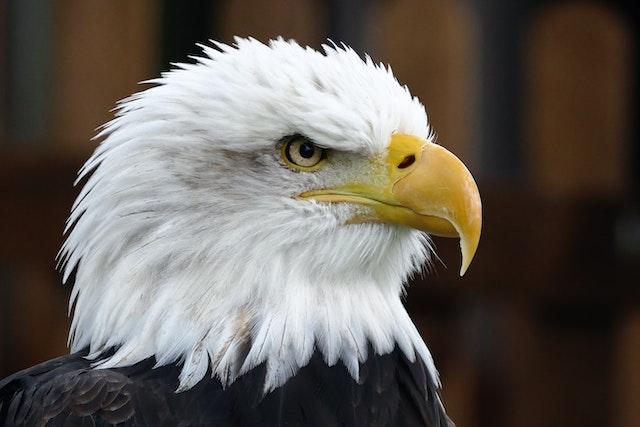
How can an eagle see so far? Eagles can see about eight times farther than humans because the cones in their eyes are very small and tightly grouped together.
There are 68 different species of eagle spread across the world. They are birds of prey that hunt by swooping down on their prey from high up. They have strong legs and very sharp talons. Quite often, they kill their prey on impact because they can swoop down at up to 50 km/h. Other times, they may carry the prey off to be eaten elsewhere. They can also kill animals such as mountain goats by swooping down and pushing them off the cliffs they perch on.
A lot of birds live close to their food sources, but eagles hunt animals so, like any predator, they have to spend a lot of energy to catch their food. Because flying requires a lot of energy, they have evolved a way of riding the rising drafts of hot air and gliding for long periods of time. These hot drafts push them high up into the sky, so they need to have very good eyesight to be able to spot their prey on the ground far below. The vision of an eagle is about eight times more powerful than ours and they can clearly see things at up to 2 miles away. How do they do this?
When we want to look at things that are far away, we relax the muscles that control the lens in our eye, which makes it thinner. The light enters the eye through the cornea, is angled by the lens, and lands on the retina at the back of the eye. The retina contains rods and cones. There are about 120 million rods and they detect light only, which is why you can’t see in color in the dark. The cones can detect wavelengths of light in the red, green, and blue spectrum. The cones convert this to an electrical signal that goes up the optic nerve to the brain. The rods are around the edge of the retina and the cones are concentrated in an area of the retina called the macula. In the middle of the macula is an area called the fovea, which is the part of the eye where we can see the clearest and is what enables us to see as far as we can.
The fovea is about 1.5 mm across and it has about 200,000 cones closely packed into it. We see by focusing the light that bounces off an object onto the fovea. The farther away from us an object is, the fewer light photons enter our eye and the lower the chance that they will land on a cone. It sounds like we have a lot of cones, but there is a lot of space between them and a lot of light that enters our eyes doesn’t fall on a cone. When an object is close to us, enough light falls on the cones that we can still see it. When the object is far away, we don’t get enough information to be able to make out any details, even if we can generally see that there is something there.
Eagles have several evolutionary changes in their eye that lets them see far farther than we can. The first is their fovea. Our fovea has about 200,000 cones, but the fovea of an eagle has over one million cones. This dense collection of cones means that much more of the light reflected from the object will land on a cone, sending a signal to the eagle’s brain.
The second difference in their eye is that the back of the eye, where the retina is, is flat, rather than round like ours. This makes yet more cones available for the light to strike and gives the eagle a much larger image than we can see, allowing them to make out details. The third thing is the size of the eagle’s eye in relation to its head. Their eyes are the same size as ours, even though they are obviously much smaller than we are. Because their eyes take up almost one-third of their heads, they can’t move them in their sockets very well, so they turn their heads to be able to see. The fourth thing is that they have much larger pupils that let in more light and they are able to their cornea and lens far more than we can, focusing the light more directly on their fovea.
The position of an eagle’s eyes give them a far greater field of view than we have. They also have much better peripheral vision and they can see far more color than we can, including ultraviolet light. All of these advantages let them see a mouse while they are flying high in the sky. And this is what I learned today.
Photo by Anthony : ): https://www.pexels.com/photo/closeup-photo-of-bald-eagle-133356/
Sources
https://www.bbc.com/future/article/20150727-what-are-the-limits-of-human-vision
https://science.howstuffworks.com/question198.htm
https://www.animalwised.com/how-do-eagles-hunt-eagle-hunting-habits-4469.html
https://www.livescience.com/33895-human-eye.html
https://journeynorth.org/tm/eagle/Vision_part1.html
